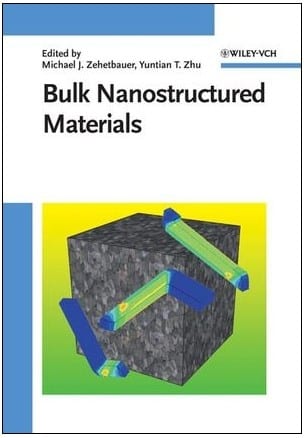Bulk Nanostructured Materials
Michael J. Zehetbauer (Editor), Yuntian Theodore Zhu (Editor)
Hardcover
736 pages
US $330.00
Reviewed by Professor Jürgen Eckert, IFW Dresden
Nanostructured materials are at the cutting edge of modern advanced materials development. Since the first papers by Herbert Gleiter in 1981 an avalanche of research and publications in different fields have appeared, spanning all the way from basic research towards industrial applications. Nanostructured materials have unique and outstanding properties due to their large surface areas introduced through nanoscale structural features such as particle or grain size, and along this line a huge amount of surfaces or internal interfaces in the material. Through this most physical and chemical properties are dramatically altered compared to coarse-grained counterparts of same chemical composition. In most cases and nowadays applications of nanomaterials, they are used in powder form.
However, bulk nanostructured materials are also very appealing for a variety of structural and functional applications. The field of bulk nanostructured materials was pioneering by Ruslan Valiev and colleagues, when showing for the first time in 1993 that nanostructured materials can be achieved through a top-down approach from bulk material by severe plastic deformation (SPD). This preparation route not only eliminates many of the problems and limitations of producing bulk material via a bottom-up approach through consolidation of powders, where often residual porosity and contamination of the material cannot be avoided, but also opens up new perspectives for obtaining products in rod, sheet or wire form that can be directly used for applications. Since the early work, a wealth or results and also first applications of this class of materials have emerged. For this reason, an overview of these results is highly demanding and timely.
As mentioned in the preface of this book, the editors attempt to tackle the whole spectrum of current knowledge on bulk nanostructured materials by compiling contributions by renowned international experts devoted to different processing routes, structure and physical property characterization all the way to simulation results and applications. Despite the fact that this book contains a huge amount of data, it is nevertheless nicely structured into six parts – each comprised of several chapters – such as to give it a clear structure and enable easy reading. Each chapter also gives an extensive list of references for the curious reader.
The first part, “Introduction and Overview“, gives a very nice introduction into the subject and lays the foundations for the basics of bulk nanostructure formation through severe plastic deformation processing of metals and introduces non-metallic bulk nanomaterials.
Part two deals with “Fundamentals” of deformation mechanisms, modelling of strength and strain hardening, and also tackles finite-element simulations and the link between molecular dynamics simulation and deformation mechanisms in nanostructured materials.
Part three is devoted to “Processing“. Here, all relevant mechanisms and results concerning different severe plastic deformation methods such as equal channel angular pressing (ECAP) and high pressure torsion (HPT) accumulative roll bonding (ARB) are given, and are very nicely complemented by the features and properties of bulk nanomaterials produced by friction stir processing, ball milling and consolidation and bulk nanostructures created through crystallization from amorphous precursors. The final chapter of this part is devoted to continuous SPD techniques and post-SPD processing, thus also showing latest trends and the vision for upscaling and industrial application.
Part four describes the “Characterization” of bulk nanomaterials by state-of-the art techniques including high resolution transmission electron microscopy, X-ray line-profile analysis and texture evolution giving all the necessary background information for structure analysis that is indeed highly demanding and indispensable for clearly understanding the structure-property relations of such materials.
Part five deals with “Properties” of bulk nanostructured materials, spanning all the way from mechanical properties of metallic systems over superplasticity, fracture and crack growth, fatigue and creep properties materials and diffusion to the structural properties of bulk nanostructured ceramics.
The final part six then considers “Applications“. The topics include multiphase ferrous and nonferrous alloys, bulk nanocrystalline and amorphous magnetic materials, niche applications of SPD-processed bulk materials and material with nanostructured surface and coarse-grained interior. This part closes with a very nice outlook towards the current state and future perspectives of the commercialization of bulk nanostructured metals and alloys.
Altogether, this book is an indispensable standard book for everybody interested in bulk nanostructured materials – their science and applications. Although intended for scientists that are already familiar or working in the field, it is nevertheless also suitable for readers that are not so much familiar with the topic. It contains a huge amount of data and gives clear insight into the different topics, but it is also easily readable and can thus also be recommended for non-specialists that are interested in the subject and want to get an overview on the current knowledge of the field.


















